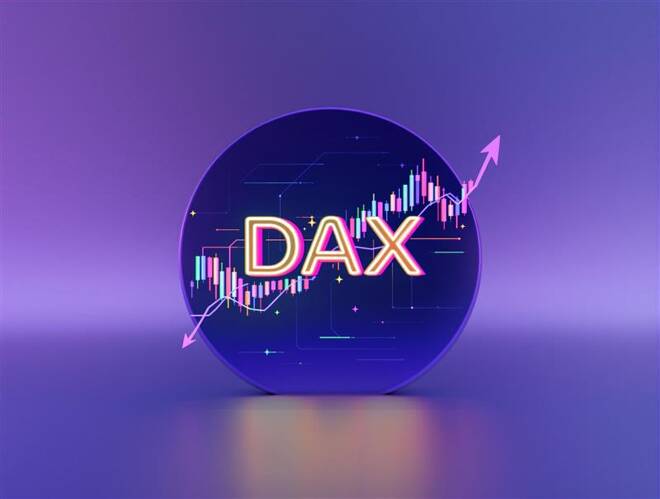Advertisement
Advertisement
Dax Index News: Forecast Eyes 24,500 as ECB Rate Cut Bets Boost Sentiment Today
By:
Key Points:
- The DAX surged to a record 24,083 on May 20 as weak German PPI data fueled ECB rate cut expectations and market optimism.
- DAX Futures signal a positive start to the Wednesday, May 21, session.
- Near-term DAX forecast hinges on trade headlines, central bank policy shifts, and global equity sentiment.
DAX Hits 24,000 on ECB Rate Cut Expectations
The DAX extended its winning streak on Tuesday, May 20, as German economic data boosted ECB rate cut bets. The DAX rose 0.42% to a closing record high of 24,036.
German producer prices fell 0.9% year-on-year in April, following a 0.2% decline in March, signaling weakening demand. Falling producer prices could pressure consumer prices, supporting a more dovish ECB stance.
ECB policy maker Klaas Knot reportedly stated that another rate cut is feasible in June.
Stock Movers: Auto Stocks Shine
Auto stocks were among the leading shares on May 20 amid easing trade tensions and rising ECB rate cut bets. BMW and Porsche rallied 2.24% and 1.80%, respectively, with Mercedes-Benz Group and Volkswagen also posting gains.
Wall Street Falls Amid Stagflation Warnings and Fiscal Concerns
US markets posted losses on Tuesday, May 20, amid stagflation warnings and rising concerns over US debt. The S&P 500 ended a six-day winning streak, dropping 0.39%, while the Nasdaq Composite Index and Dow fell 0.38% and 0.27%, respectively.
Concerns about rising prices and a deteriorating labor market raised stagflation fears, weighing on sentiment. Richmond Fed President Tom Barkin remarked:
“Higher tariffs are likely to both dampen activity and exert inflationary pressure, at least in the near term. There remains considerable uncertainty about where tariff rates will ultimately settle and what their effects will be.”
Concerns about US debt added further pressure as investors considered Trump’s tax bill and Moody’s US credit rating downgrade from Aaa to Aa1.
Fed Speakers in Focus
In the May 21 US session, investors should monitor Fed speeches. Their insights into inflation, the labor market, and monetary policy require consideration. Calls to delay rate cuts to assess the impact of tariffs may pressure risk assets, including German-listed stocks. However, rising support for a Q3 Fed rate cut to bolster the US labor market could boost risk sentiment.
Beyond the data, trade developments remain a key driver for risk appetite, particularly for the DAX.
DAX Outlook: Trade and Central Banks to Dictate Trends
The DAX’s near-term trajectory hinges on trade developments, economic data, and central bank cues.
- Bullish Case: Easing trade tensions, upbeat data, and dovish central bank signals could send the DAX toward 24,500
- Bearish Case: Renewed trade tensions, weak data, or hawkish central bank rhetoric could push the DAX toward 23,500.
As of Wednesday morning, the DAX futures were up by 17 points, while the Nasdaq 100 mini dropped 72 points, suggesting a choppy mid-week session.
Technical Setup Suggests Cautious Optimism
After Tuesday’s gains, the DAX trades well above the 50-day and the 200-day Exponential Moving Averages (EMA), indicating bullish momentum.
- Upside Target: A break above the May 20 high of 24,083 could signal a move toward 24,150. A sustained move through 24,150 may bring 24,350 into play.
- Downside risk: A break below 24,000 could enable the bears to target 23,750, with 23,500 as the next key support.
The 14-day Relative Strength Index (RSI) at 71.02 shows the DAX sitting in overbought territory (RSI > 70). Selling pressure may intensify at the record high of 24,083.
Conclusion: Monitor Macro Themes and Trade News
DAX traders should closely monitor trade news, key economic indicators, and central bank speeches for market trends.
Explore our exclusive forecasts to see whether trade optimism can send the DAX to new highs. Click here to explore our latest DAX research, macro insights, and emerging market coverage.
About the Author
Bob Masonauthor
With over 28 years of experience in the financial industry, Bob has worked with various global rating agencies and multinational banks. Currently he is covering currencies, commodities, alternative asset classes and global equities, focusing mostly on European and Asian markets.
Advertisement
